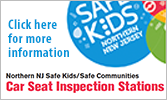Five Truths About Drowning
Each year more than 800 children drown
You think that it could never happen to your family, but each year more than 800 children drown. These incidents are not only preventable
but predictable. Here are the five truths about children who drown and what you can do to help keep your children safe around water.
Truth #1 – Weak or No Supervision
Children drown quickly and silently—in a matter of seconds. Adults who were present when a child drowns were often distracted in some way, by talking on the phone, chatting with other adults around the pool, or reading.
What you can do about it:
- Actively supervise your children around water, and have a phone nearby to call for help in an emergency.
- When there are several adults present and children are swimming, use a Water Watcher card to designate an adult as the Water Watcher to prevent gaps in supervision.
- Download the Water Watcher Card.
Truth #2 – No Barriers
Curious children, especially those younger than 4 years old, can easily find and fall in to bodies of water like pools, tubs and buckets. Often they are discovered too late to save.
What you can do about it:
- Never leave a child alone when in or near a body of water—even if it’s less than a few inches.
- For pool owners, make sure your pool has four-sided fencing and a self-closing, self-latching gate.
- Hot tubs should be covered and locked when not in use.
Truth #3 – Weak or No CPR Skills
Drowning victims who are rescued from the water need CPR immediately—before the paramedics arrive. It can prevent brain damage and be the difference between life and death.
What you can do about it
- Get certified.
- There are plenty of CPR classes available to meet busy schedules.
- Contact your local health department, hospital or visit their Web site to locate a local American Red Cross Chapter that offers courses year-round.
Truth #4 – Weak or No Swimming Ability
Children from non-swimming households are eight times more likely to be at-risk of drowning. Minority children have especially low rates of swimming ability and high rates of drowning.
What you can do about it:
- Enroll your child in swimming lessons.
- If you do not know how to swim either, enroll in a parent-child learn-to-swim class.
- To find swimming lessons, contact your local parks and recreation department, an aquatics center or visit the YMCA Web site to find a YMCA near you.
Truth #5 – Lack of Life Jacket Use
Nearly 5,000 boating accidents occur each year in open waters (lakes, rivers and oceans) and more than 700 people drown. Of those who drown, nine out of 10 are not wearing a life jacket. Also, alcohol use is involved in up to one in five reported boating fatalities.
What you can do about it:
- Have your child wear a life jacket every time you go boating or are on a dock.
- Avoid or moderate your alcohol consumption when boating.
- If you and your family boat frequently, consider taking a boating safety class through the U.S. Coast Guard.
KJ Feury RN APN, C
karenjean.feury@atlantichealth.org
Phone: 973-971-4327
Fax: 973-290-7350




